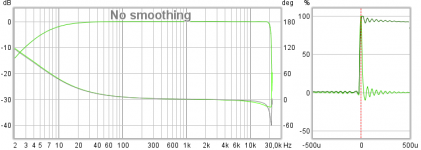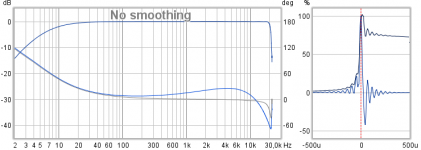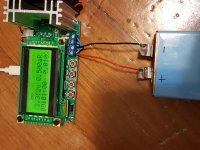I could not resist and bought two 3000F beasts 🙂 1500F@5.4V in series.
In my case 0,2A consumption 5A charging. Allowing for 0.5V drop (once fully charged) I should then charged it in minutes and play for hours. Lets see 🙂 I will also use it to benchmark other regs. Salas Ultra Bib 1.3 is comming as well.
In my case 0,2A consumption 5A charging. Allowing for 0.5V drop (once fully charged) I should then charged it in minutes and play for hours. Lets see 🙂 I will also use it to benchmark other regs. Salas Ultra Bib 1.3 is comming as well.
I could not resist and bought two 3000F beasts 🙂 1500F@5.4V in series.
In my case 0,2A consumption 5A charging. Allowing for 0.5V drop (once fully charged) I should then charged it in minutes and play for hours. Lets see 🙂 I will also use it to benchmark other regs. Salas Ultra Bib 1.3 is comming as well.
Me too, will order a pair of Maxwell 3000F from mouser today.
They are so big, as well as expensive. But assume to be the best power supply is the world, I'm just curious how good the sound quality will be 🙂
Hopefully I'll get them on Monday.
Ian
Last edited:
.
Another thing not to forget:
The PCB needs a ON/OFF switch option which disconnects ALL ultracaps from output. In my case this was not possible, thus, each time when starting up dac i had down-time because ultracaps were drained, or at least one bank, and possibly the other for lets say 95%, depending on the time when switched off.
The problem was, when switching once in 30 minutes, I had to wait at least 30 minutes before switching to charged bank.....
That is something to keep in mind when designing!
Cheers guys!
Alex
The capacitors will discharge to 0V anyway because of the auto discharge. You can look in the datasheets for the leakage current and with this value calculate how much time it requires to completely auto discharge the caps after fully charged or at different state of charge values.
If some of you consider that I am exaggerating with some aspects I can stop here my writing.
Good luck!
The capacitors will discharge to 0V anyway because of the auto discharge. You can look in the datasheets for the leakage current and with this value calculate how much time it requires to completely auto discharge the caps after fully charged or at different state of charge values.
If some of you consider that I am exaggerating with some aspects I can stop here my writing.
Good luck!
Hmm, a Maxwell BCAP0350 has leakage current of 0.3mA.
To drop from 2.7V to 2.3V (only a 0.4V drop) takes about 6 days!!!
I can assure you, my psu's in my dac are still VERY dangerous to work at even after 2 weeks of powering off...…. And I am speaking from experience, not from specs. I forgot this the first times of modifying my psu's in dac, and created a few shortings which didn't amuse me..... Welded about 30 relays and wiring!
If using a few times a week, voltage will almost NOT drop from leakage current.
That is why I would want a design which shuts off, disconnects all ultracaps if not used.
Further, it would be VERY welcome to have a start-up mode, both banks fully charged before 100% switching on.
Of course this depends on usage and design microprocessor control, there are several options of course.
NOT saying that your input is worthless!!!!!!! EVERY input is welcome and worth a lot!!!
Btw, this calculator helps a lot:
Super capacitor discharge calculator
Cheers guys,
Alex
Last edited:
Me too, will order a pair of Maxwell 3000F from mouser today.
They are so big, as well as expensive. But assume to be the best power supply is the world, I'm just curious how good the sound quality will be 🙂
Hopefully I'll get them on Monday.
Ian
Yesss, those are the holy grail, but really too big for me in my designs, i need too many different voltages and rails.
Btw, instead of Maxwell BCAP0350, which in my opinion is one of the best choices, you could also use Lishen 350F. They are made in China under license of Maxwell, and are less expensive 🙂
超電單體及模組-天津力神電池股份有限公司
Last edited:
Just a short notice about the danger of using ultracapacitors.
Please be careful to work with these guys, they are very powerful and have a VERY high shorting current. The BCAP0350 has an absolute maximum current of 170A. This is NOT shorting current!!!
The Bussmann Cooper 100F ultracaps I use have a shorting current of 225A.
The 1.8V psu's i designed have 4 in parallel, which means a shorting current of 900A.
I am not kidding, the A stands for Ampere, not mA.….
If shorting, anywhere in the circuit, everything evaporates, relay contacts incinerate, wiring will act like a blown fuse, etc. Those things can happen. And, shorting can lead to explosion danger.
So, please be careful!!
Please be careful to work with these guys, they are very powerful and have a VERY high shorting current. The BCAP0350 has an absolute maximum current of 170A. This is NOT shorting current!!!
The Bussmann Cooper 100F ultracaps I use have a shorting current of 225A.
The 1.8V psu's i designed have 4 in parallel, which means a shorting current of 900A.
I am not kidding, the A stands for Ampere, not mA.….
If shorting, anywhere in the circuit, everything evaporates, relay contacts incinerate, wiring will act like a blown fuse, etc. Those things can happen. And, shorting can lead to explosion danger.
So, please be careful!!
Thanks. I was actually thinking what would happend if connected to short circuit, which happend to me couple of time with regular regs. 🙂 and yes this is something that one should avoid.
I bought also balancing and protection circuit, which I hope prevents from such case.
I bought also balancing and protection circuit, which I hope prevents from such case.
Balancing board doesn't protect the ultracapacitor form short circuit 🙂.
Another thing I'm worry about is that if there is any possible affecting to the sound quality when the active balancing is taking action.
Please let me know if you have any related update.
Ian
Another thing I'm worry about is that if there is any possible affecting to the sound quality when the active balancing is taking action.
Please let me know if you have any related update.
Ian
I actually bought something that says: balancing and protection.
1PC 5.4V 3000F ultracapacitor protection board ( two 2.7V series together ) | eBay
I will definately try with and without to compare.
1PC 5.4V 3000F ultracapacitor protection board ( two 2.7V series together ) | eBay
I will definately try with and without to compare.
I think it's a balancing circuit with over voltage protection.
It should has nothing to do with over current protection (case of short circuit).
Ian
It should has nothing to do with over current protection (case of short circuit).
Ian
I think it's a balancing circuit with over voltage protection.
It should has nothing to do with over current protection (case of short circuit).
Ian
Thanks Ian. Good to know. I need to be carefull then and hopefully I will no fry anything 😀
Weird phase domain
Maybe below stuff have interest here, until few days ago only owned their simplest DAC chip ES9023 in form of a HifiMeDiy SABRE USB DAC UAE23 without asynchronous USB buzz, it has been a pleasure having it because musical performance was top notch used as dedicated headphone listening setup. That chain was a Win7 notebook with 64bit JRiver set to using WASAPI and do R128 algorithm tracks leveling plus Equal loudness ISO 226-2003, then a headphone amp HP-1 (tomchr design) loaded with HD650 cans. Upgraded lately to a Zoorloo ZuperDAC-S with real ES9018 not ES9018K2M including asynchronous USB buzz and was disappointed because yes expected more analytic sound but at same it was so non musical. After some comparison measurements into REW it revealed phase domain looked weird not being minimum phase so after using REW's math tools to get me a difference from minimum phase curve it was possible create a pure phase correction filter over in Rephase loaded into JRiver convolution container, and wow that filter helped a lot on natural foot tapping and musicality for this case : )
ES9023 benched at 44kHz, looks okay in that grey trace show theoretical minimum phase curve that belong to that green amplitude curve is in coherence to green phase:
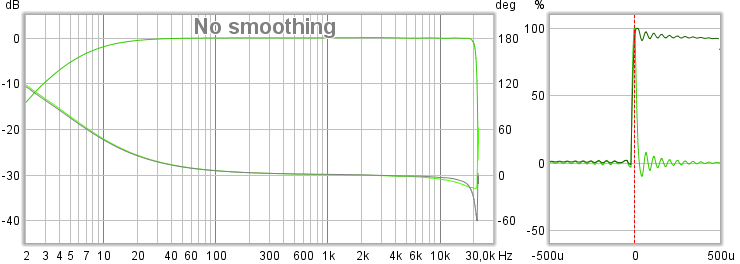
ES9018 benched at 44kHz, show a weird phase domain far from grey trace that is the theoretical phase that belongs to that blue amplitude response:
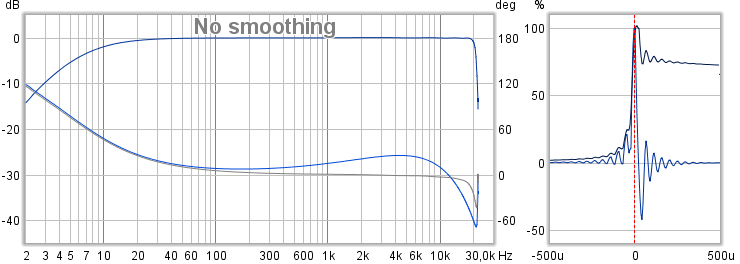
Maybe below stuff have interest here, until few days ago only owned their simplest DAC chip ES9023 in form of a HifiMeDiy SABRE USB DAC UAE23 without asynchronous USB buzz, it has been a pleasure having it because musical performance was top notch used as dedicated headphone listening setup. That chain was a Win7 notebook with 64bit JRiver set to using WASAPI and do R128 algorithm tracks leveling plus Equal loudness ISO 226-2003, then a headphone amp HP-1 (tomchr design) loaded with HD650 cans. Upgraded lately to a Zoorloo ZuperDAC-S with real ES9018 not ES9018K2M including asynchronous USB buzz and was disappointed because yes expected more analytic sound but at same it was so non musical. After some comparison measurements into REW it revealed phase domain looked weird not being minimum phase so after using REW's math tools to get me a difference from minimum phase curve it was possible create a pure phase correction filter over in Rephase loaded into JRiver convolution container, and wow that filter helped a lot on natural foot tapping and musicality for this case : )
ES9023 benched at 44kHz, looks okay in that grey trace show theoretical minimum phase curve that belong to that green amplitude curve is in coherence to green phase:
ES9018 benched at 44kHz, show a weird phase domain far from grey trace that is the theoretical phase that belongs to that blue amplitude response:
Attachments
Last edited:
Very interesting.
How did you get the plot? Which software?
Good weekend.
Ian
Thanks wishes for weekend and same to you and readers, agree its interesting but also irritating why its looks so if its true direct sound by nature are more or less mostly of minimum phase behavior, why should a reproduce product then change cycles of time domain inside audio band and manipulate with original harmonics of recording.
Benchmark/plot software is free REW its old site is here (LINK: REW - Room EQ Wizard Room Acoustics Software) but latest versions and support forum recently moved to AV NIRVANA and needs user to register there (LINK REW downloads: Downloads | AV NIRVANA) (LINK REW support forum: Official REW (Room EQ Wizard) Support Forum | AV NIRVANA).
Software used for linear or minimum phase filtering corrections are free Rephase (LINK: http://www.diyaudio.com/forums/mult...zation-eq-fir-filtering-tool.html#post3199084).
I have tested some industrial type lifepo4 (around 5AH) and they are around 10mOhm. If u get a higher AH like 30AH they can go down to 2mOhm, but it will be huge and weight around 0.7kg.
Even with 5AH, the battery can last a long time and post a simpler solution than the ultracap.
Even with 5AH, the battery can last a long time and post a simpler solution than the ultracap.
Attachments
I have tested some industrial type lifepo4 (around 5AH) and they are around 10mOhm. If u get a higher AH like 30AH they can go down to 2mOhm, but it will be huge and weight around 0.7kg.
Even with 5AH, the battery can last a long time and post a simpler solution than the ultracap.
Batteries use chemical reaction to produce power which is inherent of producing noise. LiFePo4 do produce the lowest noise of all batteries, but still there's noise.
Ultracapacitors don't produce noise, it is inherent on the design.
That is why ultracapacitors do sound better in audio applications.
Battery solution is simpler, but that simpler solution is at expense of sound quality.
I actually bought something that says: balancing and protection.
1PC 5.4V 3000F ultracapacitor protection board ( two 2.7V series together ) | eBay
I will definately try with and without to compare.
Those balancing boards have a DC resistance of 8mOhm, which is very low.
Theoretically they should degrade sound quality, but if it is noticeable at playback, that's the big question.
Again, if comparing ultracap psu to other psu designs, like Salas or other shunt regs etc., please take in mind that ultracaps suffer from burn-in time, just as every capacitor does. Please let them charge/discharge in circuitry at least for 150 hours before starting comparing them!
Further, since you use those 3000F beasts, they don't have to cycle often, it could take longer for them to burn-in fully, not sure though, I never used those marvelous 3000F monster pieces 🙂
In my dac/streamer with 120 pieces of 100F ultracaps inside, I noticed a huge improvement in sound after burn-in period had finished. Just consider this please. In my case, switch time was set at 30 minutes, so every hour they got a full cycle.
Have a good weekend!
Alex
Last edited:
out of curiosity.... whats wrong with charging and discharging supercaps at the same time using low noise charging circuit ?
surely given enough capacitance charging noise will be negligible?
surely given enough capacitance charging noise will be negligible?
out of curiosity.... whats wrong with charging and discharging supercaps at the same time using low noise charging circuit ?
surely given enough capacitance charging noise will be negligible?
Nige, I don't get the meaning of your question.
The noise I am talking about is audible in audio circuitry at playback.
Noise in psu degrades SQ. Absence of noise in voltage rails lead to blacker / darker background, better separation of voices and instruments, better resolution and soundstage. We are trying to get the most out of our audio applications.
Regards,
Alex
- Home
- Source & Line
- PC Based
- ES9018K2M, ES9028Q2M, 9038Q2M DSD/I2S DAC HATs for Raspberry Pi
